Nutrient Management
Contributors:
Julia Gaskin, University of Georgia, Athens, GA
Melony Wilson, University of Georgia, Athens, GA
Last modified - June 12, 2009
- What is nutrient management?
- Why use nutrient management?
- Why doesn't everybody use nutrient management?
Online resources for more information
Introduction
What is nutrient management?
Nutrient management is the process of managing the amount, source, timing, and method of nutrient application with the goal of optimizing farm productivity while minimizing nutrient losses that could create 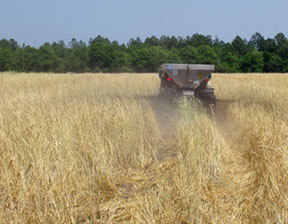 environmental problems. It includes developing nutrient budgets that consist of knowing the amounts of nutrients present in the soil, determining the amount of nutrients needed by the crop, accounting for all the potential sources of nutrients, and then applying manures, composts, irrigation water, or inorganic fertilizers to meet the nutrient need of the crop. It also uses site management practices to increase or maintain soil quality to reduce the potential for erosion and nutrient transport into surface water or nutrient leaching into groundwater. Soil quality is an important component of nutrient management because it affects nutrient retention and water movement through the soil. Biosolids are applied to a crop field in the photo at right.
environmental problems. It includes developing nutrient budgets that consist of knowing the amounts of nutrients present in the soil, determining the amount of nutrients needed by the crop, accounting for all the potential sources of nutrients, and then applying manures, composts, irrigation water, or inorganic fertilizers to meet the nutrient need of the crop. It also uses site management practices to increase or maintain soil quality to reduce the potential for erosion and nutrient transport into surface water or nutrient leaching into groundwater. Soil quality is an important component of nutrient management because it affects nutrient retention and water movement through the soil. Biosolids are applied to a crop field in the photo at right.
Why use nutrient management?
Farmers need to apply nitrogen, phosphorus, potassium and other nutrients to achieve desired crop growth and yield. However, excessive nutrient application can have negative environmental impacts. Nutrients that are not efficiently used by crops or retained in the soil can leach into groundwater and move from agricultural land into surface waters. For example, excess nitrogen in the form of nitrate can leach through the soil into groundwater. Concentrations of nitrate in drinking water above the national drinking water standard of 10 mg/L can cause health problems for infants and elderly people. Nitrate-nitrogen concentrations of 20 to 40 ppm or mg/L can cause health problems for horses and ruminants.
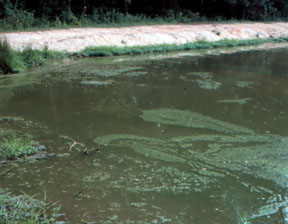 Excess nitrogen and phosphorus applied to crops can move into surface water with runoff during storm events causing nutrient enrichment (eutrophication) of these water bodies, as shown in the photo at right. Eutrophication causes excessive plant and algae growth that causes the water to turn green. When the plants and algae die, the organisms that decompose the dead material consume much of the oxygen in the water. This can cause fish kills or shifts in the types of fish species present, and can prevent recreational uses of the water. Although excess phosphorus is usually the nutrient that causes eutrophication issues in fresh water reservoirs, excess nitrogen (concentrations greater than 1 mg/L) is generally the nutrient that causes eutrophication problems in coastal waters.
Excess nitrogen and phosphorus applied to crops can move into surface water with runoff during storm events causing nutrient enrichment (eutrophication) of these water bodies, as shown in the photo at right. Eutrophication causes excessive plant and algae growth that causes the water to turn green. When the plants and algae die, the organisms that decompose the dead material consume much of the oxygen in the water. This can cause fish kills or shifts in the types of fish species present, and can prevent recreational uses of the water. Although excess phosphorus is usually the nutrient that causes eutrophication issues in fresh water reservoirs, excess nitrogen (concentrations greater than 1 mg/L) is generally the nutrient that causes eutrophication problems in coastal waters.
Although many people do not think about the relationship between soil quality and water quality, the link between them is strong (Figure 1). Good soil quality is critical to protecting water quality by functioning to hold water, adsorb nutrients, and retain other contaminants. For a soil to perform these functions, its capacity to absorb nutrients cannot be exceeded. Nutrient management is critical to maintain adequate, but not excessive nutrient concentrations for crop production and maintaining soil quality.
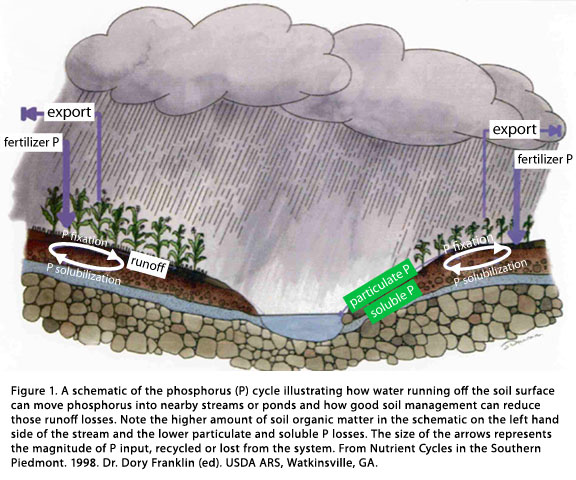
In addition to the environmental benefits, there are economic benefits to nutrient management. Evaluating what nutrients you need for an expected crop production yield and accounting for nutrients provided by the soil, manures, composts, or legumes can reduce the supplementary amount of inorganic fertilizer needed.
Many farmers use a nutrient management plan to help them make nutrient input and economic decisions. In some areas and for some crops, the nitrogen need is based on a “realistic yield goal”. This yield goal should be based on yield averages from your farm for at least three to five years. If farm yields are not available, county averages can be used.
A large part of nutrient management is record keeping. Record keeping, along with calibration of application equipment can insure proper application rates. Keeping records of all nutrients applied, cost of nutrients, crop yields, and livestock productivity will help determine what is profitable but more importantly what is not profitable for your operation. This process also helps identify what modifications should be made to improve productivity.
Why doesn't everybody use nutrient management?
Most farmers use some form of nutrient management. Using soil tests to determine the amount of inorganic fertilizer needed for a crop is a basic step of nutrient management. As the price of inorganic fertilizer increases, more people are paying close attention to nutrient sources such as legumes, manures, composts, or other byproducts to help reduce their input costs. Many producers find the annual variations in yield, crop response, climate, soil types, and manager decision confusing, but well kept records and field experience help understand and explain these variations.
Background
How is soil affected?
The key to good soil quality is soil organic matter. A sufficient amount of nutrients in the soil, particularly nitrogen, is necessary to form and maintain soil organic matter. A fertile soil has greater plant growth, which can create greater inputs of roots and other plant debris into the soil. This plant debris undergoes decomposition and adds to the soil organic matter. Applications of animal manures and composts, as well as the use of cover crops, all help increase soil organic matter. Organic matter provides a food source for soil microbes and increases microbial activity. As the microbes breakdown organic matter, nutrients are released in forms that the plants can utilize. Because nutrient management accounts for the nutrients added to the system, it promotes increasing soil quality without creating nutrient excesses.
Different soils have different capacities to adsorb and retain nutrients. This is related to the amount of soil organic matter and the soil texture (percent sand, silt, clay). Because the soil texture cannot be changed, increasing soil organic matter is the best way to increase the capacity of a soil to retain nutrients. Soils with larger amounts of soil organic matter and at a near neutral pH will have a greater capacity to retain nutrients, thus a higher soil 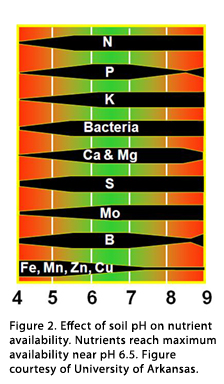 quality than soils with low organic matter.
quality than soils with low organic matter.
Soil pH also affects the availability of nutrients in the soil (Figure 2). A soil pH around 6.5 allows for maximum availability of the soil nutrients and microbial activity. Poultry and dairy manure have high levels of calcium and a natural liming affect on the soil, which can provide an additional benefit to acidic soils. Soil testing for nutrient management helps farmers track changes in pH so they know when additional lime is needed and can maintain optimal pH and nutrient availability.
Although soil organic matter can also retain some negatively charged nutrients such as phosphorus, the clay and carbonate content of the soil has a greater impact on nutrient retention. Aluminum and iron oxides found in clayey soils readily bind phosphorus; consequently, soils with greater percent clay can retain higher concentrations of phosphorus than other soil types. Soils with high carbonates also tend to bind phosphorus and reduce its loss. Sandy soils have fewer iron and aluminum oxides, therefore, have a lower capacity to retain phosphorus. If phosphorus is over-applied (which can happen when manures are used to meet the nitrogen need of a crop), the capacity of the soil to bind phosphorus can be exceeded. In these cases, the soil no longer functions as a nutrient buffer, soil quality is reduced, and water quality can be impacted.
Because soil quality affects how water moves into surface and groundwater, it plays an important role in the site management practices of a nutrient management plan. Soil organic matter helps sustain microbial activity, which in turn tends to create soil aggregates by generating polysaccharides and other compounds that “glue” soil particles together. These aggregates can help prevent soil crusting and promote better soil structure, which leads to easier root penetration, as well as improved plant growth and production. Within a soil textural class, higher soil organic matter and better aggregation will allow more water to infiltrate into the soil, reducing erosion and preventing the loss of nutrients.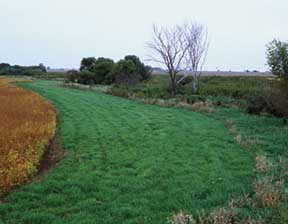
How to monitor the soil
The best way to determine the nutrient content of the soil is by testing. Soils should be tested every 1-3 years based on the soil type and state requirements or recommendations. Soil tests usually report pH, phosphorus, potassium, calcium, magnesium, sulfur, and micronutrients. In some states, the level of soil nitrate nitrogen may also be reported. From soil analyses, nutrient recommendations can be offered based on local field trials and the experience of the land grant university. All this information helps the farmer know how much lime and fertilizer is needed for a particular crop on a particular soil.
Although soil organic matter is an important indicator for soil quality, it is often not reported in a regular soil test report. Most laboratories can analyze soil organic matter or soil carbon. Asking for this analysis is helpful to determine if soil organic matter is increasing, decreasing or staying the same.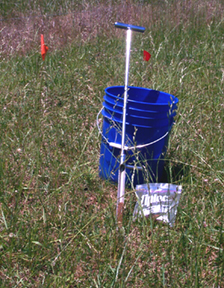
Local considerations
The specifics of a nutrient management plan are dependent on soil types, cropping systems, and site conditions such as topography and hydrology. Each state has their own specific procedures for developing a nutrient management plan based on their research and experience. It is recommended that you contact your local cooperative extension or NRCS office to receive specific guidance for your area.
How-to
Managing nutrients with inorganic fertilizers is relatively easy because nutrients can be specifically blended in the concentrations needed for a particular crop. Nutrient management can be more difficult when organic fertilizers such as manures or composts are used. This is because the nitrogen to phosphorus (N:P) concentrations in organic fertilizers tend to be around 1:1 which does not match the N:P need of most crops which is 4-6:1. Consequently, when manures are regularly applied to meet the nitrogen needs of the crop, phosphorus is over-applied.
Composts can create similar conditions, especially when manures are used as a feedstock. Composting causes nitrogen concentrations in the organic material to decrease because some of the original nitrogen is lost as ammonia gas. Phosphorus is concentrated because the volume of the material decreases during composting and it does not have a gaseous from. Consequently, the N:P ratio in compost does not match plant requirements and phosphorus can be over-applied with regular use.
Elements of a Nutrient Management Plan
Nutrient management consists of several steps:
- Testing the soil to determine the nutrient supplying power of the soil,
- Determining the recommended amounts of nutrients needed to produce the desired yields,
- Accounting for nutrient inputs from other sources, such as legumes,
- Analyzing manures, composts, and irrigation water to determine the nutrient content,
- Applying manures or composts at recommended rates and based on the critical nutrient (usually either nitrogen or phosphorus),
- Applying the additional inorganic nutrients as needed,
- Keeping records so evaluations and adjustments can be made, and
- Being aware of your surrounding landscape so sensitive areas can be protected.
This process is an important step in building and maintaining soil quality. For more information on developing a nutrient management plan for your area, contact your local NRCS or Cooperative Extension representative.
Online Resources for More Information
Animal Waste Awareness in Research and Extension (AWARE) – www.agp2.org/aware/
Iowa Manure Matters - http://www.extension.iastate.edu/pages/communications/epc/homepage.html
Animal Waste Management - http://www.bae.ncsu.edu/programs/extension/manure/awm.html
Best Management Practices for Colorado Agriculture: An Overview
http://www.ext.colostate.edu/pubs/crops/XCM171.pdf
Livestock and Poultry Environmental Learning Center - http://www.extension.org/animal+manure+management
Pennsylvania Nutrient Management
http://cropsoil.psu.edu/extension/facts/agfact16.pdf
Agricultural Phosphorus and Eutrophication USDA/ARS publication
http://www.sera17.ext.vt.edu/Documents/AG_Phos_Eutro_2.pdf
Manure Incorporation and Crop Residue Cover – University of Nebraska-Lincoln
http://www.ianrpubs.unl.edu/epublic/live/g1563/build/g1563.pdf
Agricultural Nitrogen Management for Water Quality Protection in the Midwest
http://www.ianrpubs.unl.edu/epublic/live/rp189/build/rp189.pdf
Agricultural Phosphorus Management and Water Quality Protection in the Midwest http://www.ianrpubs.unl.edu/epublic/live/rp187/build/rp187.pdf
